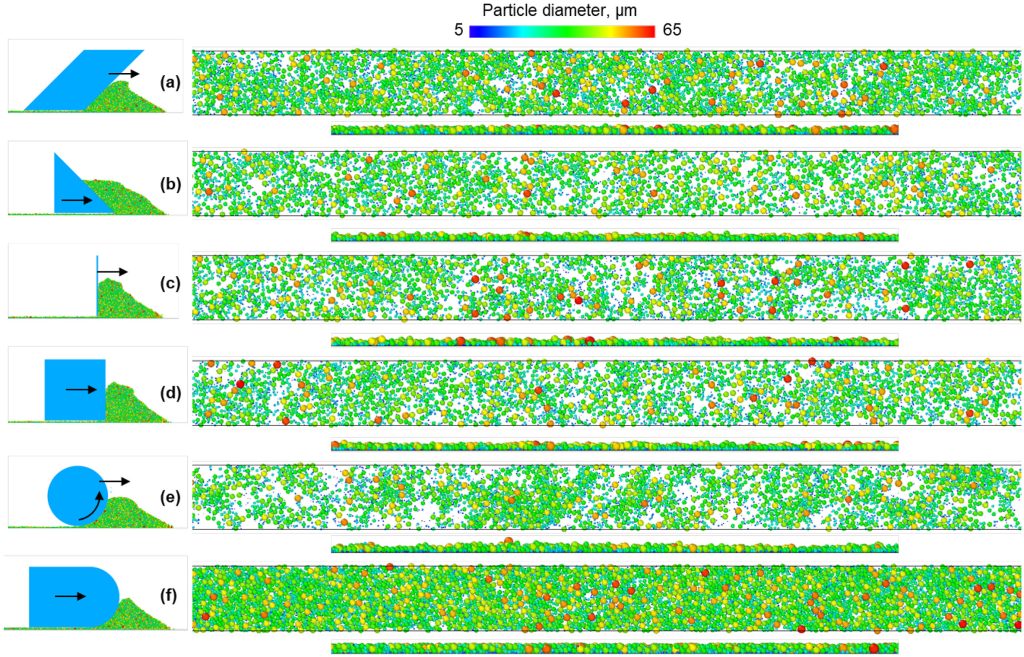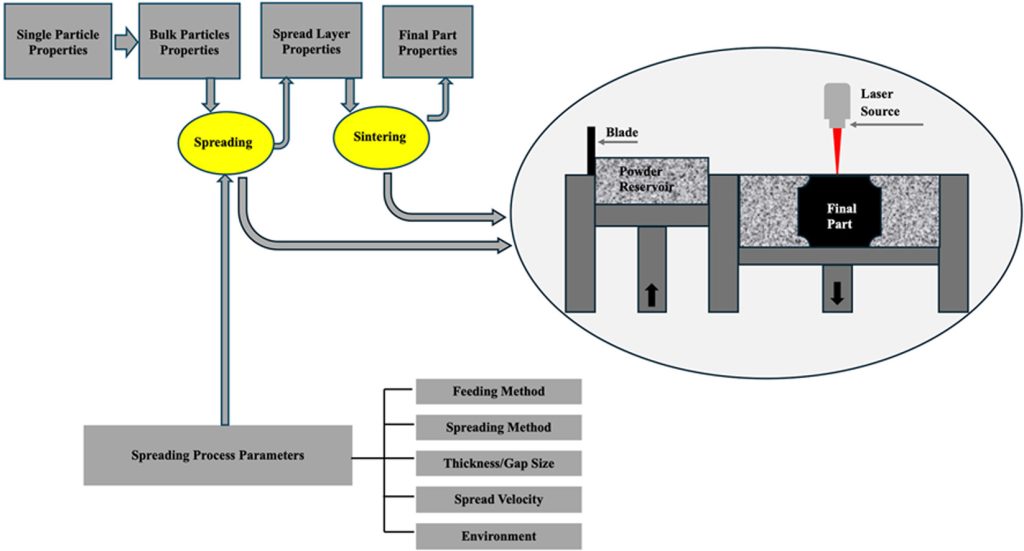ELEGOO Saturn 4 Ultra 16K Resin 3D Printer with Flip-up Lid, Smart Tank Heating at 30℃, 150mm/h High Speed Printing, Large Printing Size of 8.33x4.66x8.66 Inches
$519.99 (as of June 19, 2025 23:45 GMT +00:00 - More infoProduct prices and availability are accurate as of the date/time indicated and are subject to change. Any price and availability information displayed on [relevant Amazon Site(s), as applicable] at the time of purchase will apply to the purchase of this product.)In the article “New Research Overview on Powder Spreadability in PBF 3D Printing,” the latest study delves into the critical role that powder spreadability plays in the Powder Bed Fusion (PBF) 3D printing process. Conducted through a collaborative effort between the University of Leeds, University of Greenwich, and Cormica Limited, this research has been published in Particuology under the title ‘Spreadability of powders for additive manufacturing: A critical review of characterisation methods.’ It aims to address notable gaps in existing literature on powder spreading dynamics, emphasizing how properties like particle size, morphology, and flow behavior, as well as environmental factors and spreading systems, impact the final quality of 3D printed parts. The article also discusses the challenges in developing accurate tools to measure powder spreadability and suggests advancements such as in-situ monitoring software for improved process control. Prominent industry examples are provided, including Phase3D’s Fringe Research software for real-time anomaly detection and Velo3D’s Assure Quality Assurance system, illustrating the benefits of integrated analysis and monitoring techniques in enhancing 3D printing performance. Have you ever wondered how the quality of a 3D printed part is influenced by the tiny particles that form it? In the intricate world of Powder Bed Fusion (PBF) 3D printing, the way these powders spread plays a crucial role. Let’s dive into the latest research on powder spreadability to better understand its importance.

$30 off $400+ Anycubic Products with code AC30OFF
New Research Overview on Powder Spreadability in PBF 3D Printing
Recently, a collaborative study conducted by the University of Leeds, University of Greenwich, and Cormica Limited sheds light on this very topic. Published in Particuology under the title ‘Spreadability of powders for additive manufacturing: A critical review of characterisation methods’, this research strives to fill significant gaps in the existing literature concerning powder spreading dynamics in PBF 3D printing.
Understanding Powder Spreadability
Powder spreadability refers to how easily and uniformly powders can be distributed across a build platform in PBF 3D printing. This is paramount as inconsistent spreading can result in defects and poor mechanical properties in the final product. The quality of 3D printed parts hinges on how well the powder behaves during spreading.
Research Aim
The primary aim of this research is to provide a comprehensive understanding of how different factors affect powder spreadability. It evaluates how properties such as powder size, shape, and flow behavior, along with environmental conditions and spreading mechanisms, impact the quality of 3D printed parts. By addressing these variables, the research seeks to elucidate the complexities of powder spreading, contributing valuable insights to the field of additive manufacturing.
Impact Factors on Powder Spreadability
Understanding the factors influencing powder spreadability can seem complex, but breaking them down can make it more digestible. Let’s explore what the research identifies as key impact factors.
Powder Properties
The characteristics of the powder itself, such as size, shape, and flow behavior, are fundamental in determining how well it spreads. Powders with irregular shapes or a wide size distribution can cause uneven layers, affecting the final product’s quality.
Table 1: Key Powder Properties
| Property | Description |
|---|---|
| Size | Smaller and more uniform particle sizes tend to spread more uniformly. |
| Shape | Spherical particles typically offer better flowability compared to irregular shapes. |
| Flow Behavior | Powders need to flow freely to ensure consistent layer deposition. |
Environmental Conditions
Environmental factors such as humidity, temperature, and the velocity of the spreader also play a crucial role. For example, high humidity can cause powders to clump, leading to uneven spreadability.
Spreading Systems
The type of spreader and its operational speed influence how effectively the powder layer is formed. Different systems and speeds can produce varying results, which need fine-tuning to optimize spreadability.

Buy Photon Mono M5 Get Free 1KG Resin
Challenges in Measuring Spreadability
Accurately assessing powder spreadability is challenging due to the dynamic nature of PBF 3D printing. Traditional measurement techniques often do not directly correlate with real-world spreading conditions, leading to discrepancies in data.
Traditional Techniques
Existing techniques primarily measure indices rather than the direct properties of the powder. This makes it difficult to predict how the powder will behave during the actual printing process.
Table 2: Traditional Measurement Techniques
| Technique | Index Measured |
|---|---|
| Angle of Repose | Measures static angle of a pile of powder |
| Flow Rate Through a Funnel | Measures flow rate under gravity |
Need for In-Situ Monitoring
To address these challenges, the research advocates for the development of in-situ monitoring tools. Such tools would provide real-time data on powder behavior during the spreading process, allowing for adjustments to enhance process control and repeatability.
Important Findings from the Research
The study brings forth several crucial discoveries about the role of powder spreadability in PBF 3D printing. Let’s delve into some of the most significant findings.
Impact on Consistency and Quality
Consistent spreadability is essential for producing high-quality 3D printed parts. Any inconsistency in the powder layer can lead to defects such as porosity, weak mechanical properties, and dimensional inaccuracies.
Powder Characteristics
The research underscores the importance of powder characteristics, including size, morphology, and flow behavior. It highlights that standardized measurements often fall short of correlating well with actual spreading conditions, making it necessary to develop more accurate characterization methods.
Environmental and Process Factors
Environmental conditions such as humidity and temperature, as well as the type and speed of the spreader, significantly impact the printing performance. The study finds that these factors can either positively or negatively influence the spreadability of the powder.
Suggested Improvements
To improve the consistency of powder spreadability, the research suggests implementing in-situ monitoring systems. These systems can provide real-time feedback, allowing for immediate adjustments to maintain optimal conditions.

Development of Testing Tools
Developing tools to assess powder spreadability poses its own set of challenges. The research discusses the need for advanced metrics that provide accurate and reliable measurements.
Current Testing Tools
While there are several existing testing tools, they often lack the precision required to replicate actual PBF printing conditions. The study emphasizes the need for tools that can measure direct powder properties rather than just indices.
Future Tool Development
The development of new tools should focus on real-time monitoring and the ability to adjust parameters dynamically. Such advancements would greatly enhance the predictability and control of the powder spreading process.
Industry Examples Enhancing Powder Spreadability Insight
Several industry players are already making strides in enhancing powder spreadability insight. These examples highlight the practical application of the research findings.
Phase3D’s Fringe Research Software
Phase3D has developed Fringe, a software that offers real-time anomaly detection during the 3D printing process. This tool helps in identifying and correcting issues related to powder spreadability, thereby improving overall print quality.
Velo3D’s Assure Quality Assurance System
Velo3D’s Assure Quality Assurance system monitors the 3D printing process to detect defects in real-time. By providing instant feedback, it ensures that powder spreading issues are addressed promptly, maintaining the quality of the printed parts.

Comprehensive Understanding and Combined Methods
The research concludes that a comprehensive understanding of powder spreadability requires a combination of different methods and correlated analysis. This holistic approach would provide a more accurate picture of how powders behave during the PBF printing process.
Combining Methods
Using multiple methods to assess powder spreadability can offer a more detailed and accurate understanding. By correlating data from various tests, researchers can gain insights that single-method approaches might miss.
Conclusions
The study emphasizes the critical role of powder spreadability in PBF 3D printing. By exploring powder properties, environmental factors, and the importance of in-situ monitoring, the research provides a comprehensive overview that can significantly impact the field of additive manufacturing.
Final Takeaways
In summary, understanding and improving powder spreadability can lead to more consistent and higher-quality 3D printed parts. The collaborative research from the University of Leeds, University of Greenwich, and Cormica Limited shines a light on the complexities of this topic, offering valuable insights and practical solutions for the industry.
$30 off $400+ Anycubic Products with code AC30OFF







